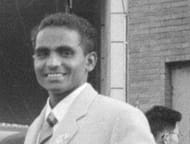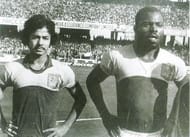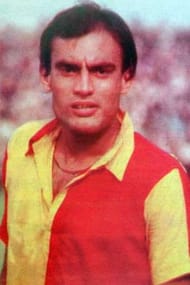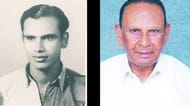In football, the eleven players on the field each have an important role to play. The goalkeeper remains vigilant and is the last defender and the first attacker, often relaunching and recycling strategic plays. The ball then traverses the length of the field, up and down, left and right, cross-field, until it reaches the attacker who attempts to convert the opportunity and unleash a wave of euphoria.
Defenders make sure that the same does not happen in return, by staying compact and often putting their bodies on the line to salvage and maintain a hard-earned lead.
But it is the midfielders that make or break a team. This is the playing position that offers the most flexibility in creativity, tactics, movement and panache, but demands superhuman fitness in return. Speed, agility, reflexes, stamina: a midfielder needs to excel at all of these for the entire duration of the game and yet, when the plaudits are given out, midfielders are often overlooked in favor of players that have a specialized role in the team, whether it be keeping the ball out of the net or smashing it in with elegant ease.
Today we will be giving them their due and appreciate the top 5 midfielders in Indian history.
Honourable Mentions:
We decided to do an honourable mentions category for this post simply because there have been too many midfielders that have played outstanding football for the country and it feels imperative to give them the recognition that many of them, unfortunately, do not receive.
Mohammed Salim
Mohammed Salim’s inimitable on-the-ball skills delighted and surprised European crowds. He was the first Indian to sign a European contract and, although he only stayed there for a few months, his legacy remained large at Celtic FC. His contributions to his club team was of such magnitude that Mohammedan SC won their first-ever Calcutta Football League title and extended that to five successive wins. Salim remains a great example of a winger to this day.
Noor Mohammed
In the age of 1-2-7, 2-3-5 and 3-3-4 formations, the rare players who sat back assumed an important responsibility: they soaked up all of the pressure and were vital components of any title-chasing squad. Noor Mohammed was all of this and more. As a left-half, his positioning and tackling skills at his peak were unmatched in Asia and, unsurprisingly, he was a regular member of India’s playing eleven for more than a decade.
Mohammed represented India in the gold-winning 1951 Asian Games, 1948, 1952 and 1956 Olympics and played a pivotal role in India’s fourth-place finish at the 1956 Games. At the domestic level, Noor Mohammed remained a one-club player despite numerous offers from prestigious clubs and dedicated his entire career to the Hyderabad City Police team.
Renedy Singh
Renedy Singh’s natural skills were unmissable to the extent that he made his senior international debut at the age of 19. His talent lies in his being able to cross the ball with both feet and his dangerous dead-ball skills.
Singh signed a loan deal with CSKA Sofia in 2015 but his constant injuries have seen him transition from a player to a manager. He is currently the Assistant Manager of FC Pune City and the President of the FPAI (Football Players Association of India).
Jo-Paul Ancheri
A midfielder is undoubtedly the most complete player in any playing eleven. Jo-Paul Ancheri is the most complete player. Period. He has played as a striker, a defender and rumour has it even a goalkeeper (that’s not true but it wouldn’t be surprising if it were), but by far his most effective position has been as a midfielder.
His versatility meant that he was a mainstay of the Indian national team from 1992-2004, and his on-field persona was such that he also captained the Indian team through one of its roughest patches, laying the foundation and groundwork for players like Baichung Bhutia to come in and take the team up a notch.
Even after he retired from the international team, Ancheri has been a major proponent of football in India, founding the Indian Football Foundation (IFF) that aims to coach and bring up youth talent to ensure that the Indian football team has a healthy pool of players increasing in quality and being more competitive at the international level.
#5 Mohammed Yousuf Khan
A lot of football fans in India are unfortunately not Indian football fans. Those that maintain a casual interest in the current national team’s endeavors are aware of India’s struggles to even qualify for, let alone challenge other teams for, major football tournaments. But sixty years ago the setting was different. The Indian national team was widely regarded as the best in Asia and a fourth place finish in the 1956 Olympics meant that India was the first team ever from Asia to make it to the semifinals of the football event.
In this environment, Mohammed Yousuf Khan came into the side and played some of the most dynamic football seen by an Indian team. Known as the “bearded horse” for his quick covering of the pitch, Yousuf Khan terrorised defences with his relentless onslaught of passing and movement that would dizzy even the most practiced of defenders.
One of the few footballers India has produced that would qualify as ‘global’ or ‘international’ in their quality, Yousuf Khan played a vital role in India’s 1962 Asian Games triumph and was one of only two Indian athletes to be selected in the 1965 Asian All Stars XI.
Yousuf Khan was born in Andhra Pradesh on 5 August 1937 and was a prominent member of the Hyderabad City Police team. He also represented the tactics of the great Syed Abdul Rahim, the most successful coach in Indian football, on the field, ensuring that the master tactician’s plans came to fruition.
Unfortunately, the Indian Government and the AIFF did not recognize the value of Khan’s sacrifice, who, due to multiple head traumas, suffered from Parkinson’s disease and suffered a painful journey to death. He received almost no help or support during his lengthy period of illness and had to sustain his family on a pension of Rs. 3500 per month.
Accolades
1960 Rome Olympian, 1962 Asian Games gold medal winner, 1965 Asian All-Star XI, recipient of the Arjuna Award in 1966.
#4 Mariappa Kempaiah
Kempaiah Da was born in Bengaluru on 4 March 1932. His defining quality in the Indian side was his impeccable fitness and unmatched stamina. While originally choosing boxing as his preferred sport, Kempaiah Da chose to enter football as a career.
Aiding this decision was his long-distance running capabilities, which had built up his stamina. Starting his career from the Bangalore Muslims, Kempaiah gradually rose to prominence within the Indian footballing sphere owing to his versatility on the field. He could play both in the centre and as a wing-half, which is a trait that was uncommon then and is even rarer now in the current era of specialist players.
In his long playing career, Kempaiah featured for both the arch-rivals East Bengal and Mohun Bagan, while representing the national team in all major tournaments since his debut vs Sri Lanka in 1955. He was a mainstay in India’s most successful national team of all time, finishing fourth in the 1956 Olympics and the 1958 Asian Games while finishing second in the Merdeka Cup in 1959.
His fitness regime was the pride of India’s coach, Syed Abdul Rahim, and the envy of all his other teammates. Kempaiah Da would run 30 laps on an off-day and would take a dozen extra laps every day, after training was completed. Kempaiah was credited with being one of the only Indian players to have a fitness level that was at par with any English professional player, according to Harry Wright, India’s coach after Rahim’s death.
At the club level Kempaiah Da played for East Bengal until 1956 when, on loan at Mohammedan Sporting, he beat Mohun Bagan in the final to win the Rovers Cup. Mohun Bagan were so impressed with Kempaiah’s performance that they signed him at the beginning of the next season, where he eventually retired.
He helped Bagan win three consecutive Durand Cup titles and three consecutive IFA Shield titles as well. His extraordinary ability to close down opponents and snatch the ball was unrivalled in the country. If a player managed to pass him once, his repeat tackles would inevitably ensure turning over of the possession.
Unfortunately, Kempaiah Da’s post-retirement life was a sad one, as is typical for many former greats of Indian football. He died after suffering from diabetes and was quietly forgotten. He lives on in the memories of his contemporaries and us.
Accolades
1956 Melbourne, 1960 Rome Olympian, 1962 Best Wing Half Award, 2000 Sportsman of the Millenium, five-time Durand Cup winner, three-time IFA Shield winner
#3 Krishanu Dey
In India, we seem to have a penchant for labelling anyone that displays even a hint of quality as an “Indian” XYZ, whether or not those qualities are even slightly present in the person. With this player being dubbed the “Indian Maradona”, chances are that this statement is hyperbolic and cannot be substantiated by facts.
That would be wrong. Krishanu Dey definitely fits the bill with his looks, but his on-field performances are no laughing matter. Dey, along with his partner-in-crime and best friend off the field Bikash Panji, was the most sought-after footballer in the 1980s and 90s, with arch-rivals Mohun Bagan and East Bengal vying for his signature.
Krishanu Dey’s immaculate dribbling with bursts of acceleration, combined with his vision for completing passes in the narrowest of spaces made him worthy of the comparison. Enjoying a cult status amongst his fans in Bengal, Krishanu was tipped to be one of the best midfielders in Asia but his diminutive figure and troublesome injuries meant that he was constantly underestimated and had to prove his critics wrong at every stage of his career.
Krishanu Dey isn’t without his spectacular national moments. He didn’t have a hand in his goals, but his brace against South Korea and hat-trick against Thailand in two games of the Merdeka Cup in 1986, accompanied by his tournament-winning performances for the inaugural SAFF Championship, meant that the former Indian captain’s international career was a successful one.
But even before these achievements, he helped India qualify for the 1984 Asian Cup Games for the first time in 20 years, and in the process kick-started a revival of the Indian national team’s Asian competitiveness.
Dey’s life was tragically cut short when a pulmonary embolism resulted in organ failure. In the end, it was football which gave him and took away his life.
Accolades
Indian Football Association’s (IFA) U-19 tournament was renamed in his honour.
#2 Sudip Chatterjee
“Tulu da” was the stable cog of the Indian team that revived its fortunes following the era of storied success in the 50s and 60s. Where Krishanu Dey was diminutive, Sudip Chatterjee stood tall, towering over other players. This did not impede his movement, which was impeccable over 90 minutes of the game.
Chatterjee played for Mohun Bagan as a defender after starting his career as one, but he moved into a new role along with a new club in 1984 at East Bengal. That is where he became one of the most respected and feared footballers in the country.
Sudip Chatterjee featured for India in a whole host of tournaments that included the 1982 Asian Games, the 1984 AFC Asia Cup, Olympic and FIFA World Cup qualifiers, the Merdeka Cup, and captained the side in the South Asian Federation Games, the Nehru Cup, the 1986 Asian Games and the 1988 and 1992 AFC Asian Cup. Notably, he was one of the rare players who featured for the Indian national team before playing for any of the traditional big clubs at the time. His talent was such that national scouts ensured his international career was a lengthy and successful one.
Sudip Chatterjee retired from the game in 1992 after his ill-health prevented him from performing at the highest levels. Tulu da was diagnosed with dementia soon after and passed away in 2006 due to a cardiac arrest.
Accolades
1986 AIFF Player of the Year, 1994 AIFF Player of the Decade.
#1 Ahmed Khan
It is perhaps unsurprising that the ‘Magician of Indian Football’ tops this list. Of all the players featured so far, none had the menacing, animalistic aura that was present in the snake charmer's game.
Playing as an inside-left or No. 10, Ahmed Khan was part of the legendary ‘Paanch Pandavas’ front-line for East Bengal FC during the era of the 2-3-5. In the modern day, he would be classified as a creative attacking midfielder, with his ability to play between both lines and stretch defences. His on-the-ball skills were unmatched by any player, on either team, during the course of the game and his ability to score with either foot left crowds mesmerized.
Born the son of a famous footballer (Baba Khan), Ahmed Khan’s destiny had been written with football being the edict: all of his siblings played professionally as well. Born in then-Bangalore, Khan grew up in a time when football was much more aligned to the mainstream as a genuine sport in the country.
He featured in India’s first-ever participation at the Olympics in 1948 and scored a spectacular consolation goal in a 10-1 thrashing by Yugoslavia. This, while playing barefoot. Ahmed Khan’s incisive attacking led India to their first gold medal in the Asian Games of 1951-52 in New Delhi.
Khan’s affinity for expensive cigarettes is a hint at his entertaining persona off the field; he also loved playing cards and watching films.
One of Ahmed Khan’s unique qualities was that he never featured for East Bengal’s arch-rivals, Mohun Bagan. His loyalty to the club and the fans was unparalleled and as a result, he is still revered in Kolkata today.
Accolades
3-time Calcutta Football League winner (1949, 1950, 1952), 4-time IFA Shield winner (1949-51, 1958), two-time Durand Cup winner (1951-52), 1949 Rovers Cup winner, 1951-52 Asian Games gold medal winner
For more articles like this and all news related to the wide world of Indian football, please click here. For ISL specifically click here. Let's Football.





